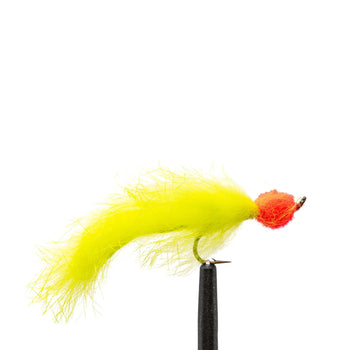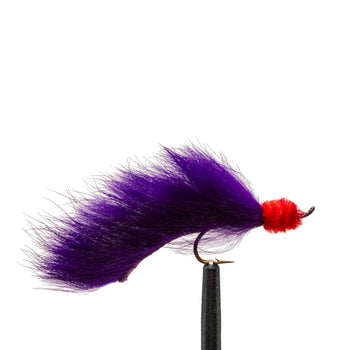Fly of the Month: The Egg-Sucking Leech

November is a pivotal time for anglers, as many fish species prepare for winter and become more aggressive during spawning season. One fly that consistently shines under these conditions is the Egg-Sucking Leech. This pattern uniquely combines the natural movement and bulk of a leech with the visual appeal of an egg imitation, making it irresistible to a range of fish. To expand on this staple pattern, we’ll explore the egg-sucking bunny leech variation, which offers even more versatility and effectiveness for late fall fishing.
Why the Egg-Sucking Leech?
The Egg-Sucking Leech is especially effective during spawning season, as it imitates both a leech and a bright fish egg. During this period, predatory fish become highly protective of their nests, making them more likely to strike aggressively. This pattern works particularly well when swung through deeper runs or slowly stripped through slow-moving pools, where territorial fish lie in wait.
Target Species for Egg-Sucking Leeches and Variants
These patterns are designed to attract predatory, aggressive fish that respond to the combination of a leech’s lifelike movement and the flash of an egg. Brown trout are particularly responsive during the fall, often striking defensively in spawning zones. Similarly, rainbow trout and steelhead are drawn to these flies, especially in rivers and streams with active spawning grounds. These flies also work well for brook trout and salmon, as both species will strike a leech with an egg imitation to protect nests or feed on dislodged eggs. In stillwater environments, bass and char may also respond to egg-sucking patterns, particularly in deeper pools or along the bottom, where they tend to feed in colder months.
How to Fish the Egg-Sucking Leech
-
Swing it through deep runs: This fly performs best in deep water where fish stage for spawning. Let the current carry the fly naturally, and add short, quick strips to simulate the darting motion of a leech.
-
Perfect for cold water: As temperatures drop, fish become more lethargic. The bright egg imitation combined with the leech’s profile helps grab attention even in colder conditions.
-
Vary your retrieve: Adjust retrieval speed to water conditions. Use a slow, steady retrieve in calm water and quick, erratic strips in faster currents to trigger more aggressive strikes.
Recommended Colors and Sizes
- Colors: Black, olive, and purple are popular body colors for egg-sucking leeches. Eggs should be tied in bright shades like orange, pink, or chartreuse.
- Sizes: These patterns are typically tied in sizes 4-6 for targeting larger fish, though smaller versions may work in specific conditions.

|

|

|

|
| Purple Egg-Sucking Leech - Flame Egg | Black Egg-Sucking Leech - Cherise Egg | Purple Egg-Sucking Leech - Chartreuse Egg | Black Egg-Sucking Leech - Orange Egg |
Best Environments for Egg-Sucking Leeches
- Deep pools and runs: These flies excel in deeper water where fish gather for spawning. Focus on slow-moving or still waters.
- Lakes and reservoirs: Both egg-sucking and egg-sucking bunny leeches work well in stillwater environments, especially when stripped slowly near the bottom, where fish actively search for prey.
The Egg-Sucking Bunny Leech: Extra Movement, Extra Flash
The Egg-Sucking Bunny Leech is a bulkier variation, often tied with rabbit strips for added movement and lifelike undulation in the water. This pattern is effective at drawing aggressive strikes during spawning season, particularly in deeper pools and slower-moving water. The bright egg head on these flies adds another layer of attraction, making them highly effective in various water conditions.
- Fishing Tips for the Egg-Sucking Bunny Leech: Strip the fly slowly with intermittent pauses, allowing the rabbit fur to pulsate and mimic the movement of a wounded leech. This undulation often triggers instinctual strikes from predatory fish.

|

|

|
| Chartreuse Egg-Sucking Bunny - Orange Egg | Black Egg-Sucking Bunny - Chartreuse Egg | Purple Egg-Sucking Bunny - Orange Egg |
The Egg-Sucking Bunny Leech is particularly effective for enticing strikes in deeper water, especially when fish are actively defending their territory. While the bunny leech’s bulk and pulsating action make it ideal for slower strips and pauses, the traditional Egg-Sucking Leech offers a more streamlined approach, making it versatile for a range of retrieval techniques.
Final Thoughts
As the days shorten and water temperatures drop, egg-sucking leeches and their variations become some of the most reliable patterns for November fishing. Whether you’re targeting aggressive brown trout, territorial rainbows, or opportunistic bass, these flies will help you land more fish. Carry a variety of colors and profiles to adapt to the conditions, and enjoy the rewards of late-fall fishing.







